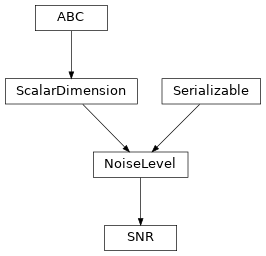SNR¶

The signal to noise ratio (SNR) is a measure used in science and engineering that compares the level of a desired signal to the level of background noise. It is defined as the ratio of signal power to the noise power.
- class SNR(snr, reference, channel=None)[source]¶
Bases:
NoiseLevelSignal-to-noise ratio configuration.
- Parameters:
snr (float) – Expected signal-to-noise ratio.
reference (Device |Transmitter | Receiver) – Reference of the noise level, i.e. with which power / energy was the signal generated.
channel (Channel, optional) – Channel instance over which the signal was propagated. For channel models that consider propagation losses the noise power is scaled accordingly.
- property level: float¶
Linear signal power to noise power ratio.
- Raises:
ValueError – If the ratio negative.
- property reference: Device | Transmitter | Receiver¶
Reference to which the noise level is scaled.
Can be either a device, transmitter or receiver. If assigned to a device,
- property snr: float¶
Linear signal power to noise power ratio.
- Raises:
ValueError – If the ratio negative.